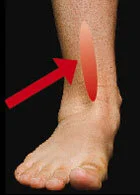RESEARCH
TIBIAL STRESS SYNDROME (SHIN SPLINTS)
Shin splints is a common term for pain or inflammation in the front or inside section of the tibia (tibial stress syndrome).
SYMPTOMS
The patient will complain of tightness or tenderness and sometimes throbbing pain along the border of the tibia. The symptoms occur with a specific activity (especially running and walking long distances) and often settle with rest. Often, it will start with a dull ache but quickly become sharper and more aggravated.
BIOMECHANICAL ETIOLOGY
Anterior tibial stress is often experienced by new runners or walkers when pain occurs in the anterior muscles of the shin during exercise.
Posterior shin splints (medial tibial pain) is a more chronic condition occurring along the inside edge of the tibia. It generally occurs with overuse during sports.
Both conditions are related to excess stretching (traction) of soft tissue structures along the shin bones (tibia and fibula). Excessive subtalar joint pronation and internal tibial rotation increase the medial tractional forces upon the deep flexors and extensors of the leg. This is a common factor in muscular overuse conditions and commonly exhibits secondary periosteal swelling due to tractional forces placed upon the soft tissue structures on the tibia and fibula.
TREATMENT
By preventing excess subtalar joint pronation, orthotics assist reduction of internal tibial rotation and reduce medial tractional forces upon anterior tibialis and posterior tibialis muscles. This provides an effective solution to shin splints pain.
ADDITIONAL TREATMENT
Ice therapy (15 minutes, 3 times a day)
Rest from running
Deep tissue massage
EXERCISES
Stretching and strengthening of tibial muscles:
Sit on a chair and loop an ankle weight around the foot.
Keep the leg straight and lift the foot up and down from the ankle.Calf stretches

